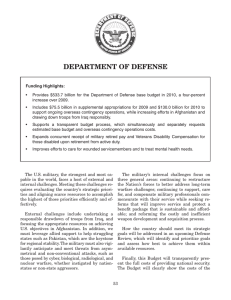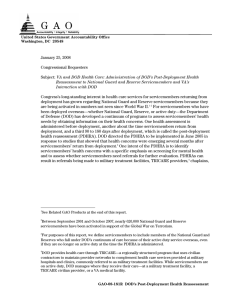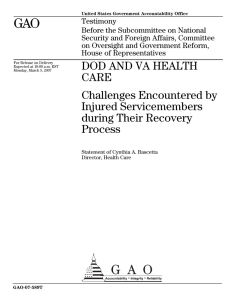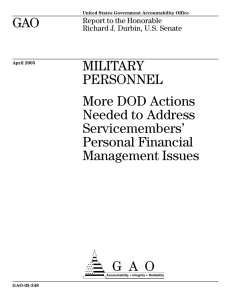DEPARTMENT OF DEFENSE
advertisement
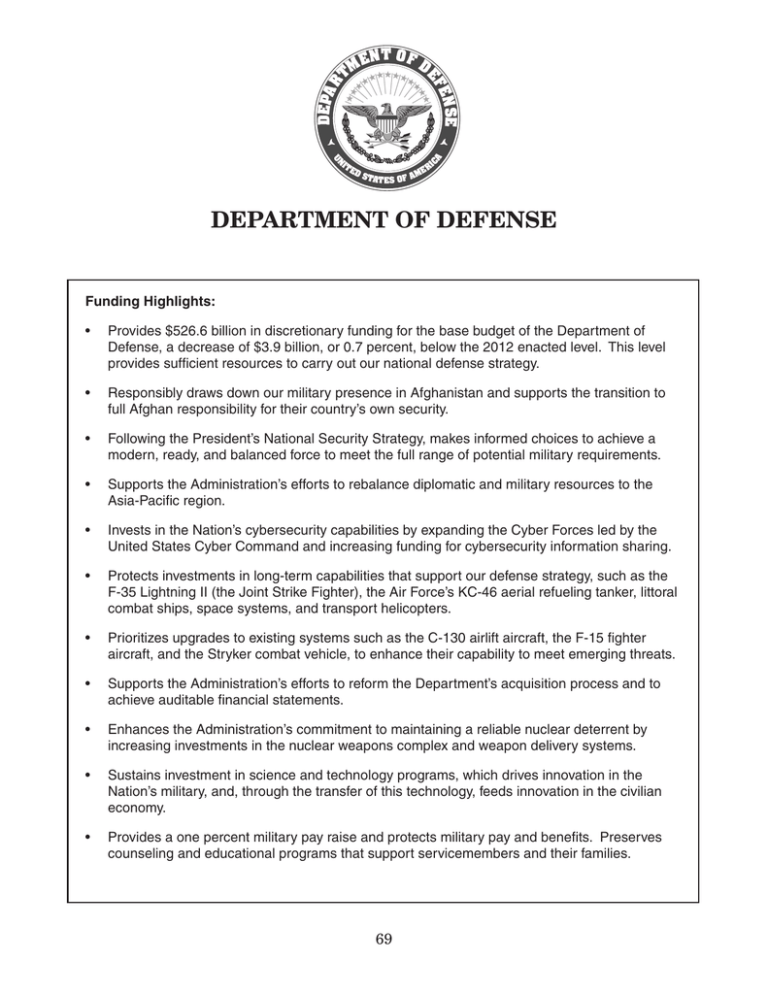
Department of Defense Funding Highlights: • Provides $526.6 billion in discretionary funding for the base budget of the Department of Defense, a decrease of $3.9 billion, or 0.7 percent, below the 2012 enacted level. This level provides sufficient resources to carry out our national defense strategy. • Responsibly draws down our military presence in Afghanistan and supports the transition to full Afghan responsibility for their country’s own security. • Following the President’s National Security Strategy, makes informed choices to achieve a modern, ready, and balanced force to meet the full range of potential military ­requirements. • Supports the Administration’s efforts to rebalance diplomatic and military resources to the Asia-Pacific region. • Invests in the Nation’s cybersecurity capabilities by expanding the Cyber Forces led by the United States Cyber Command and increasing funding for cybersecurity information sharing. • Protects investments in long-term capabilities that support our defense strategy, such as the F-35 Lightning II (the Joint Strike Fighter), the Air Force’s KC-46 aerial refueling tanker, littoral combat ships, space systems, and transport helicopters. • Prioritizes upgrades to existing systems such as the C-130 airlift aircraft, the F-15 fighter ­ aircraft, and the Stryker combat vehicle, to enhance their capability to meet emerging threats. • Supports the Administration’s efforts to reform the Department’s acquisition process and to achieve ­auditable financial statements. • Enhances the Administration’s commitment to maintaining a reliable nuclear deterrent by increasing investments in the nuclear weapons complex and weapon delivery systems. • Sustains investment in science and technology programs, which drives innovation in the Nation’s military, and, through the transfer of this technology, feeds innovation in the civilian economy. • Provides a one percent military pay raise and protects military pay and benefits. Preserves ­ counseling and educational programs that support servicemembers and their families. 69 70 Department of Defense • Takes steps to control rising health care costs without sacrificing quality of care and seeks to improve key needs such as mental health services for servicemembers and their families. • Enables servicemembers to transition more smoothly and effectively to their lives as civilians and veterans through revamped transition assistance programs that provide information and resources, focusing on servicemembers’ individual career goals. The 2014 Budget provides $526.6 billion for the Department of Defense’s (DOD’s) base funding in 2014, representing a decrease of $3.9 billion, or 0.7 percent, below the 2012 enacted level. The Budget continues to pursue strategic priorities that reflect our Nation’s renewed commitment to our historical role in the Asia-Pacific region. It also targets resources toward other strategic priorities such as increasing our ability to effectively navigate the security challenges and opportunities of cyberspace, continuing to focus funding on research and development, and combatting terrorism. The Budget maintains our commitment to providing servicemembers with the right mix of equipment, infrastructure, and training. It sustains our commitment to the All-Volunteer Force—the backbone of our modern military—and seeks to better support our servicemembers and their families in particular, by helping separating servicemembers transition more effectively to civilian life. It also continues to support DOD’s efforts to reform the acquisition process and to achieve auditable financial statements. Supports Overseas Contingency Operations The Budget’s Overseas Contingency Oper­ ations (OCO) funds will continue to ­support the incremental costs of military operations in Afghanistan, as well as other activities that primarily support Operation Enduring Freedom (OEF). Looking forward to the responsible end of the war in Afghanistan, U.S. forces will gradually draw down and complete the transition to full Afghan responsibility for their country’s security by the end of December 2014. OCO funds will support military operations, incremental personnel costs, force protection, repair and replacement of damaged equipment, activities to counter and defeat improvised explosive devices, intelligence activities, support for coalition partners, and the training, equipping, and sustaining of the Afghan National Security Forces. Beyond Afghanistan and OEF, small amounts of funding will continue to support Iraq-related costs, including repair and replacement of equipment and munitions damaged or lost in the war and the operation of the Office of Security Cooperation-Iraq. OCO funds will also continue to fund the portion of temporary Army and Marine Corps end strength that supports current operations in Afghanistan and elsewhere, but that will not be required under the Nation’s defense strategy. Final decisions about the pace of the drawdown in Afghanistan have not yet been made. As a result, the Budget includes a placeholder for DOD’s 2014 OCO funding, equivalent to the amount provided in the President’s 2013 Budget. The Administration continues to propose a multiyear cap that limits Government-wide OCO funding to $450 billion over the 2013 to 2021 period, including $96.7 billion for OCO-funded activities in 2013. The Administration will submit a Budget amendment to the Congress updating the OCO request after a determination has been made on required force levels in Afghanistan. Aligns Resources with Strategic Priorities R e b a l a n c e s A s i a - Pa c i f i c A l l i a n c e s . The United States and its interests are inextricably linked with Asia’s economies and security. After more than a decade of war in Iraq and Afghanistan, DOD and other agencies are devoting greater energy and resources to revitalizing 71 The Budget for Fiscal Year 2014 U.S. alliances and economic ties across the AsiaPacific region. DOD’s overarching objective in the region is to sustain a stable security environment and a regional order rooted in economic openness, peaceful resolution of disputes, democratic ­ governance, and political freedom.­ The Budget funds critical investments in the region that further this objective. It provides $95 million for Guam military infrastructure to bolster Guam’s position as a strategic hub in the western Pacific while taking important steps toward establishing fully capable Marine Air-Ground Task Forces in Japan, Guam, and Hawaii with the intent to rotate forces to Australia. It also provides resources to support up to four Littoral Combat Ships that would maintain a rotational presence in Singapore to improve the ability to counter a range of transnational threats in the region. In addition, the Budget supports increased militaryto-military cooperation and training, which will help build the capacity of allies and partners to address security challenges. These and other investments, along with increased engagement with the region, are critical to the Government-wide effort to promote regional security and ensure the free flow of commerce and trade throughout the region. Improves Cyberspace Operations and Cybersecurity Information Sharing. Cyber attacks targeting the financial industry and the Government demonstrate that no sector, network, or system is immune from cyber penetration by those who seek to make financial gain, to perpetrate malicious and disruptive activity, or to steal commercial or Government secrets and property. Cyber threats are constantly evolving and require a coordinated and comprehensive way of thinking about cyberspace activities. The Budget includes improvements to cyberspace ­activities, such as:­ • Cyber Forces Led by the U.S. Cyber Command. Cyber investments will grow in response to emerging threats in cyberspace. Teams of cyber experts—including defensive, intelligence, and analytical—will defend the Nation, as well as DOD infrastructure, by conducting reconnaissance, surveillance, ­ development, maintenance, and analysis. • Cybersecurity Information Sharing. The Comprehensive National Cybersecurity Initiative Five (CNCI-5) seeks to connect cybersecurity centers and other cybersecurity analytics electronically and in real time. The Budget provides an increase in funding for CNCI-5 to develop a comprehensive coordinated cybersecurity information sharing system that will serve as the foundation for cybersecurity information sharing requirements across the Government. This system will also develop and publish machinereadable interoperable technical standards that will allow for automated information sharing. The goal is for relevant pieces of information to make their way to authorized users throughout the Government, to help connect the dots in identifying cybersecurity threats. Counters Terrorism. Protecting the United States from terrorism remains a national security priority. The United States and its allies have had many successes against terrorist groups, but the priority of fighting terrorism remains, even as the specific threats have changed. The Budget continues to prioritize this mission by funding investments that are consistent with the four principles of the National Strategy for Counterterrorism, including: combatting terrorism in ways that are consistent with core U.S. values; building the capacity of our partners to fight terrorism; developing systems and capabilities to defend American citizens and deny terrorists safe havens; and preventing terrorists from developing, acquiring, or using weapons of mass destruction. Invests in Current and Future Capabilities Funds Military Readiness and Training. The budget environment is challenging both because of fiscal considerations and because we are beginning the difficult process of reset- 72 ting and restoring our force’s ability to conduct the full range of military operations in support of the current defense strategy. The Budget meets these transitional challenges even as the force structure and future funding levels are reduced. Training and readiness are the foundation of ensuring a capable military that provides the President with a range of options to deter or defeat aggression or coercion against the United States and its allies, friends, and interests. The Budget provides $176.2 billion for the operations, training, and supporting activities troops need to defeat current and future threats. The Budget also requests authorization for another Base Realignment and Closure round in 2015 to close or realign excess infrastructure and avoid wasting limited resources maintaining unneeded facilities. The actual closing of any bases would involve a multiyear process that would not start until 2016, after the economy is projected to have more fully recovered. Provides Needed Weapons Systems for the Challenges of Today and Tomorrow. The Administration is committed to providing servicemembers with the modern equipment they need to defend the Nation. To this end, the Budget provides $166.8 billion to develop and buy weapons systems that can meet emerging threats and that support our defense strategy. For example, the Budget includes $8.4 billion to continue the F-35 Lightning II (Joint Strike Fighter) aircraft program, which is designed to counter threats posed by a sophisticated adversary, and $5.4 billion for the VIRGINIA class submarine to provide asymmetric capabilities, such as improving the Navy’s ability to operate in coastal waters and support special operations forces, that are appropriate to our defense strategy. In addition, the Budget proposes $653 million to strengthen the Nation’s secure communication links in space by procuring additional Advanced Extremely High Frequency satellites. While the Administration is committed to continuing its investment in new weapons systems needed to ensure that America’s military remains the finest in the world, it is also focused on mitigating the adverse impact of budget constraints Department of Defense on the modernization effort whenever possible by continuing to maintain and upgrade proven existing systems. For example, DOD will continue to use the highly-capable C-130 airlift aircraft rather than procure a new airlifter such as the C-27. In addition, although DOD will also continue to use new Global Hawk Block 30 Unmanned Aerial Vehicles that have already been procured, as well as the proven U-2 reconnaissance aircraft for the critical task of providing intelligence to our troops, it will terminate further procurement of Block 30 Global Hawks. DOD will also retain proven systems such as the F-15 and F-16 fighter aircraft and the B-2 bomber, upgrading them as necessary to enhance their effectiveness, and will field double-v hulls on the Army’s Stryker combat vehicles and upgrade the suspension and drive train of Paladin self-propelled howitzers, to improve troop protection, survivability, and mobility. Modernizes the Nation’s Nuclear Deter­ rent. The Administration remains committed to reducing the number and role of nuclear weapons in support of our national security strategy, to modernizing the Nation’s nuclear weapons complex, and to supporting the goals of the Nuclear Posture Review as the United States and Russia implement the New Strategic Arms Reduction Treaty (New START). The Budget proposes $12 billion for strategic offensive forces, $600 million or five percent, less than the 2012 enacted level; the principal reason for the decrease was the twoyear slip in the funding profile for the OHIO Class replacement. To ensure that the strategic bomber fleet will be able to conduct future ­missions, DOD is continuing to develop a new long-range bomber. DOD continues to review possible reductions in delivery systems to ensure that the New START thresholds are met on schedule. Close cooperation between DOD and the National Nuclear Security Administration (NNSA) at the Department of Energy has resulted in modified weapons system requirements that focus on the highest-priority capabilities. DOD and NNSA continue to ensure that plutonium component production and research capabilities are maintained at required levels, and have increased re- 73 The Budget for Fiscal Year 2014 sources for several programs to extend the service lives of nuclear weapons, as well as for one ongoing major capital asset project, the Uranium Processing Facility. Reflecting their close partnership and shared commitment, DOD continues to provide ­budgetary support to NNSA. Funds Research and Development for the Military of the Future. The Administration continues to support strong investment in research and development (R&D) for national security. The Budget provides $67.5 billion for DOD research, development, test and evaluation activities. This funding supports DOD efforts to: evaluate new tactical vehicles; continue to develop the Air Force KC-46 aerial refueling tanker; continue to design the OHIO class ballistic missile submarine replacement; and advance other critical technologies. This research funding also capitalizes on DOD’s important role in advanced manufacturing and the development of other forward-looking capabilities, including hypersonics. The Budget also invests in early-stage science and technology (S&T) programs to support the warfighter. The Administration continues to encourage a strong national investment in R&D, and the Department’s R&D activities, especially investments in DOD’s S&T program, are a key component of this Government-wide effort. The Budget includes $12 billion for the S&T program. This funding supports basic research, applied research and advanced technology development. The Budget also provides $2.9 billion for the Defense Advanced Research Projects Agency and its breakthrough research, an increase of 1.8 ­ percent above the 2012 enacted level. Conserves Energy. As one of the largest organizations in the world, DOD consumes almost three-fourths of all energy used by the Federal Government. Consuming that much energy— whether fuel for planes, ships, and tanks, or electricity for bases, commissaries, and schools—has budgetary and strategic impacts. To mitigate those impacts, DOD seeks to be more deliberate about how it uses energy, in line with the Administration’s overall approach to energy efficiency, such as by improving the fuel efficiency of existing equipment, developing and fielding innovative energy technologies, expanding renewable energy sources, and improving the energy efficiency of buildings. The Budget provides $2 billion for initiatives to reduce fuel consumption, and provides $1.2 billion for initiatives to reduce facility energy consumption, including funds to retrofit existing buildings, meet higher energy efficiency standards for new buildings, and develop renewable energy projects. The Budget also includes $150 million for the Energy Conservation Investment Program, which improves the energy efficiency of DOD facilities worldwide, and provides $32 million for the Installation Energy Test Bed Program to demonstrate new energy technologies to reduce risk, overcome barriers to ­deployment, and facilitate wide-scale c­ommercialization. Reforms Acquisition Process. The Better Buying Power (BBP) initiative further implements DOD’s best practices to strengthen buying power, improve industry productivity, and provide an affordable, value-added military capability to the warfighter. Launched in 2010, BBP encompasses a set of fundamental acquisition principles to achieve greater efficiencies through affordability, cost control, elimination of unproductive processes and bureaucracy, and promotion of competition. Today’s constrained funding environment makes it even more important that DOD find effective means to increase its purchasing power for goods and services. New BBP initiatives address current fiscal realities, including enforcing affordability caps, measuring cost performance, and aligning contractor profitability with acquisition goals. DOD has instituted best practices, including applying lessons learned, expanding strategic sourcing, establishing acquisition professional reviews, and instituting peer reviews to ensure effective competition. Strengthens the All-Volunteer Force Supports Servicemembers and Their Families. The Administration places a strong ­ focus on military family programs, sustaining funding at $8.5 billion to ensure consistent and 74 effective services across military installations. DOD provides a broad spectrum of programs and services for servicemembers and military families including: mental health and counseling services; deployment assistance; child care and youth programs; morale, welfare, and recreation programs; commissaries; DOD-run schools for military dependents; military spouse employment programs; and many other services. DOD is working to improve its support to the All-Volunteer Force by identifying and discontinuing redundant or less effective military family programs, while increasing support for programs that are proven to serve military families well. For calendar year 2014, consistent with the views of the uniformed military leadership, the Budget provides a 1.0 percent increase to basic pay, a 4.2 percent increase in the Basic Allowance for Housing, and a 3.4 percent increase in Basic Allowance for Subsistence. This compensation level recognizes the sacrifices made by the men and women in our Armed Forces, while adhering to the current ­budget constraints faced by DOD. Promotes Health of Servicemembers and Their Families. To provide quality health care for the Nation’s 9.6 million eligible military beneficiaries, the Budget provides $49.4 billion for the DOD Unified Medical Budget that supports the DOD Military Health System. The Budget sustains strong programs that support wounded, ill, and injured servicemembers and their families, and which help servicemembers transition into civilian life and the workforce. In particular, DOD is improving its support for servicemember mental and emotional health by increasing collaboration among suicide prevention programs, working to eliminate the stigma associated with accessing mental health services, and improving the effectiveness of DOD programs. To this end, DOD has started assessing the effectiveness of over 160 DOD psychological health programs and will realign resources by the end of 2014 to support the most effective programs and replace those that are less effective. DOD will sustain funding to improve electronic health record ­access. Department of Defense DOD continues to seek efficiencies and cost savings within the Military Health System. The Budget supports adjusted TRICARE cost sharing requirements to address health care cost increases and make the health benefit more sustainable. Survivors of members who died while on active duty and disability retirees and their family members will be exempt from the fee and copay adjustments. DOD and the Department of Veterans Affairs will jointly work on a study to identify best practices and efficiencies within their healthcare systems. Helps Servicemembers Transition to Civilian Life and Jobs. In the past year and a half, the Administration has worked to make the transition from military to civilian life easier. DOD, along with several other Federal agencies, has focused on creating a “career-ready” military and on increasing veteran employment. The Budget supports the first major redesign of the interagency Transition Assistance Program in over 20 years, which will provide more information and better resources to servicemembers as they begin to navigate civilian life. A new program, entitled Transition GPS (Goals, Plans, Success), will help servicemembers prepare for civilian life by providing pre-separation assessment and individual counseling, a five-day core curriculum, an additional curriculum tailored to the servicemembers’ individual career goals, and a capstone event to verify that transitioning servicemembers have met certain standards that show they are ready for their civilian careers. DOD is also working to streamline civilian credentialing for servicemembers and veterans, so that they can better communicate to civilian employers the valuable skills they learned in service to the Nation. For example, the first action of the Military Credentialing and Licensing Task Force, working with manufacturing credentialing agencies, has enabled up to 126,000 servicemembers to gain industry-recognized, nationally-portable certifications for high-demand manufacturing jobs.
